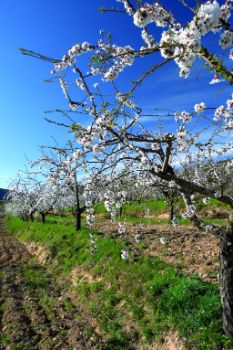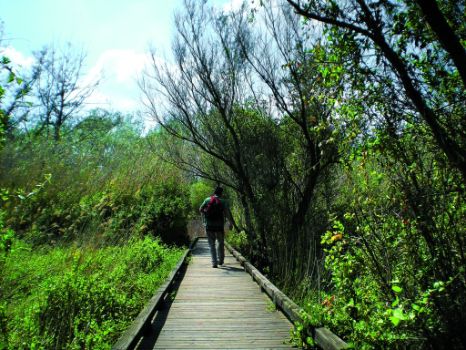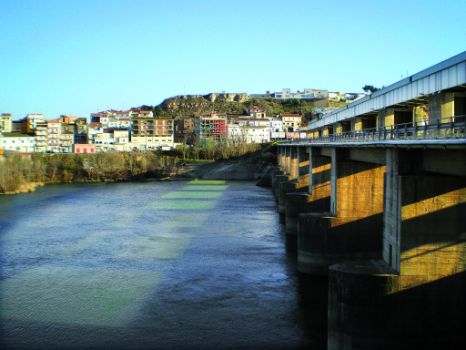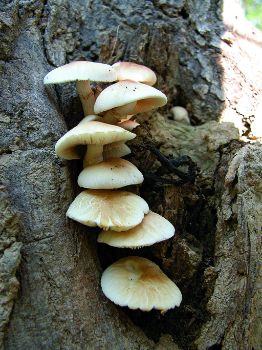Net of Natural
Trails

Stage 37: Almatret - Flix
Description
The Sebes Nature Reserve and the Flix Meander
This new stage of the Ebro Nature Trail begins on the eastern ledge of the Almatret plain, whence it sharply descends the slopes of Escambriu to the banks of the Ebro, level with the Riba-roja d’Ebre bridge. This brings you to a very different sector. As far as Flix, the route follows the towpath running along the left bank of the Ebro, crossing the Sebes Area of Natural Interest. Besides visiting the interpretation centre and bird observatories, you can follow various marked trails. After crossing the Flix dam-bridge, climb up to the village proper, which is in the neck of a narrow meander.

Leaving Almatret along Carrer de Sant Joan heading east, walk a short distance until you come to an impressive stone monolith with a cross, which you must leave behind on the left to take the forest path on the right. This section continues between almond groves, until it passes a water tank and several repeater antennas, which are distributed on both sides of the path, before arriving at the Pauls and Fatarella viewpoint. 350 m further on, leave the main path and go along a branch which, making a 180º turn, turns left and heads towards the viewpoint of the Riba-roja reservoir and the Escambrons peak. However, if you want to follow the route in this stage, 200 m before reaching the reservoir, you will have to leave the track to take another secondary track on the left.
The Nature Trail now descends the shady slope of Escambrons and then along the watershed, until it widens. At this point there is a trail that goes off to the right and leads to the ruins of what was once Mas Cremat.

At this point, turn left onto a path that initially follows the watershed and, a few metres further on, slopes off to the left and begins its descent, zigzagging down the shady slope of a gorge. You will have to make several turns before emerging onto a track with a somewhat precarious surface at the head of the first cultivated strips. If you take it to the right you will go around a small cirque that will guide you to a more frequented agricultural track. You will reach the upper track under a small building. From here, along a flat path, the route reaches the headwaters of three watercourses in a southerly direction, finally reaching an important recently-built track.
Take this track to the left, go down the cultivated gully of the Vall d’Ombrenc ravine and cross it three times before coming out onto an paved path, very near the banks of the Ebro. In this situation you can see that, on the left, the Nature Trail continues towards Flix while, on the right, after a few metres you will reach the bridge of Riba-roja and, through it, the town of the same name (1.5 km from this point).
The town of Riba-roja, crowned by what used to be its Templar castle and walls, stands on a rocky reddish outcrop. Today, the village has an important area of orchards and irrigated land on either bank of the Ebro and it has services. You can also take the train to connect with stage 36.1 in Fayón, and continue along it to Mequinenza.
The path continues towards Flix, following the left-hand path from the crossroads, which continues northeast, ignoring the entrances to houses and side fields.

This route takes you to the Les Sénies cliffs - a good viewpoint near the river bank - and, after the Mas de Favó, you ascend a steep slope and enter the Sebes Wildlife Nature Reserve, where you can see the beautiful islands of Mauritius and, later, Querol.
The route then turns as it skirts strips of old olive groves and reaches a crossroads. At the crossroads, take the road on the right which descends to the shore and which, after a ruin, goes through reed beds and thick riverside vegetation. Once you have passed the ornithological facility at the Cigonyes viewpoint, you will reach the car park of one of the Reserve’s walks: the Passera de la Ribera (a walkway that runs through the marshes to an old riverbed, shaded by poplars and ash trees, with reeds and bulrushes that provide a refuge for the rich bird life). Continuing along the main path, you will reach the Mas del Director, an old farmhouse that has been refurbished as an interpretation centre and the beginning of another short route to a bird observatory.
Continue along the path, heading east, and cross the Sant Joan gorge to return to the bank of the Ebro. The path ends at the C-230 road, which is crossed using an underpass, beside an industrial area and the bridge that is also the dam of the Flix reservoir. Once you reach the other bank of the Ebro, you can go up to the town centre by following a street on the left and, having crossed it completely, you will arrive at the boat crossing where this stage ends.
Sites of interest
Puntos de interés
Culture
Infrastructure
Municipality
Hostel
Vegetation
Profile

Highlights
Further information
Flix
In the early 20th century, the chemical company SEQF set up premises in Flix to use its old weir as a hydroelectric dam. This put an end to the old water wheel that served the Flix orchard and turned it into an industrial town.
Its town centre, at the neck of a narrow meander of the river, has always been a privileged place for defending and surveillance of river navigation: a castle, in the middle of the apex of the bend, is evidence of this. Its boat crossing and the one at Miravet are the only operational towboats in the entire Catalan Ebro.
Sebes Nature Reserve
On the left bank of the River Ebro, upstream of the Flix dam and bridge, is this unique river area. The Sebes Nature Reserve conserves an important riparian forest, an extensive reedbed, river islands with lush vegetation and the fauna typical of this kind of environment. Moreover, the Mas del Director Interpretation Centre is undertaking two interesting programmes. The reintroduction of the white stork and the controlled growth of reed beds by grazing Camargue horses. It is strongly recommended that you make a visit to the information centre, the viewpoint and the recovered reed bed lagoon, the stork observatory, or simply take a stroll along the riverside forest walkway.






